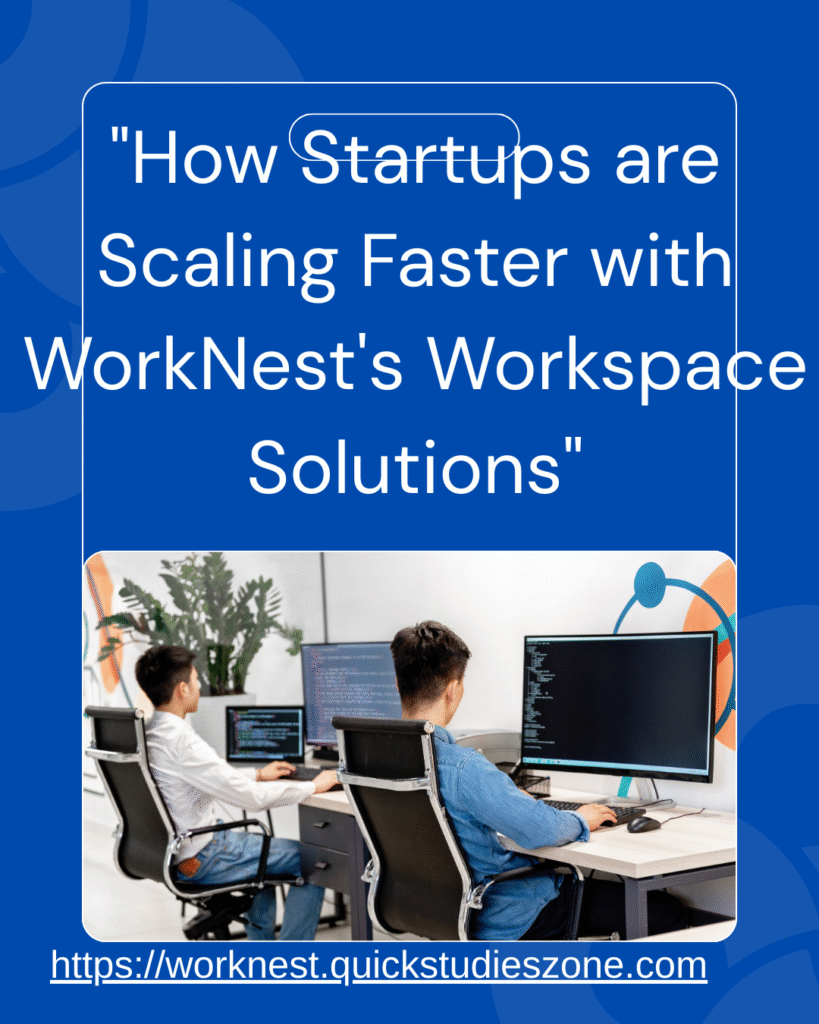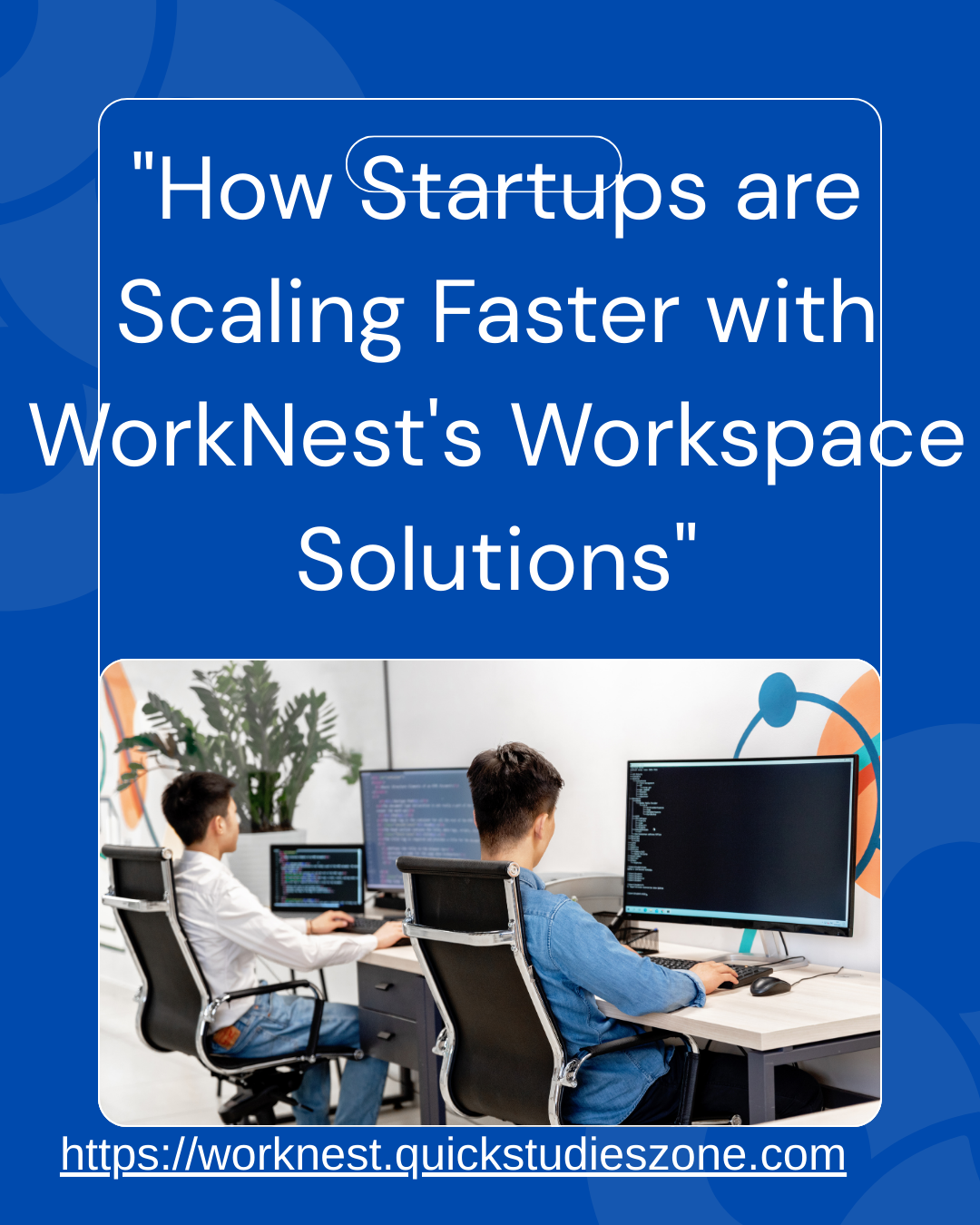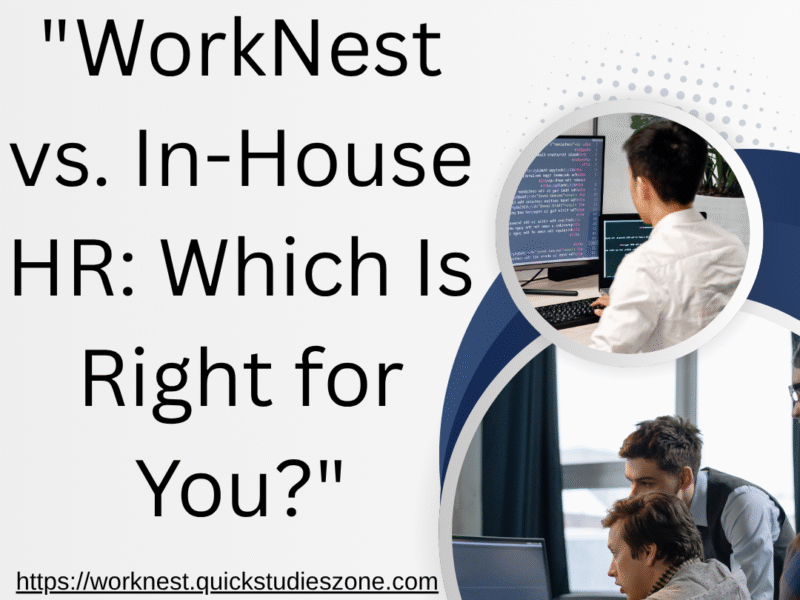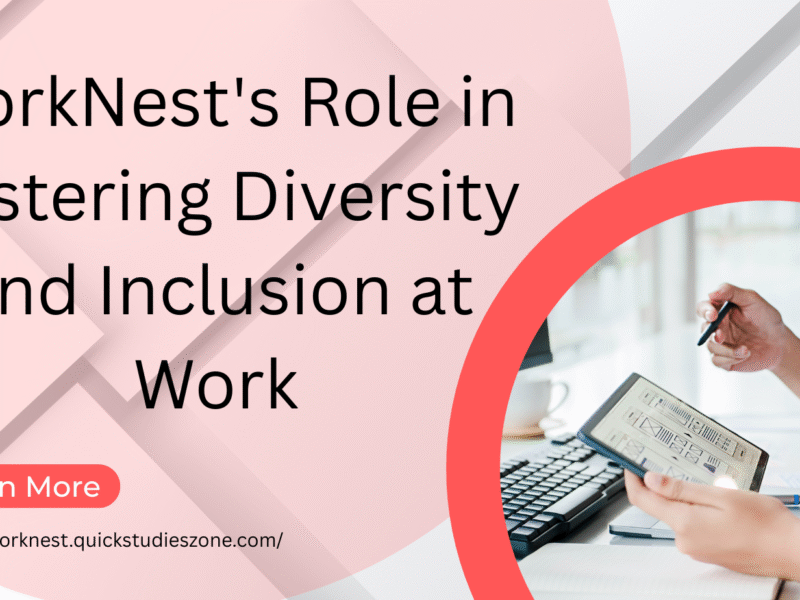-
Introduction
Growing a startup is among the most difficult stages in a life cycle. The shift of a small and scrappy team to a growing organization requires additional talent and capital, as well as infrastructure, operations, culture, and flexibility.“How Startups are Scaling Faster with WorkNest’s Workspace Solutions” One of the most important infrastructure decisions is the workspace environment: where your people operate, cooperate and create.
Introducing WorkNest – a work studio that is flexible, has amenities and community to enable startups to grow intelligently. In this paper, we will discuss how startups are scale companies more quickly, at a lower cost and with increased team congruency using offerings (coworking, private offices, hybrid models, dedicated desks, virtual offices, etc.).
We will dig into:
The scaling problems of startups.
The reason why conventional office leases tend to be bottlenecks.
The workspace of WorkNest and its services.
Significant processes through which WorkNest enhances scaling.
Case studies and examples.
Considerations and best practices of using WorkNest by startups.
The pitfalls to watch out and how to avoid them.
Predicting the trends of workspace and the ways WorkNest can grow.
Conclusion & call to action
Let’s dive in.
1. The problems of Scaling Startups.
It is important to get straight on why workspace decisions are important in scaling before we get into the solution.
1.1 Rapid headcount growth
Startups tend to staff up and down within a short period of time – engineering, sales, marketing, operations – dozens of people within months. A work area that was effective with 5 persons is not always going to be effective with 50 or 100.
1.2 Geographic growth & satellite divisions.
Some of the start-ups seek to expand to new markets (cities, regions, countries). Physical footprints or local presence is useful in terms of hiring, customer confidence as well as operations. However, entering new geographies implies balancing between leases, domestic regulations, logistics, and expenditures.
1.3 the cost control and capital efficiency.
The fixed line items can be office real estate which is usually one of the largest costs. Lease of long term, security deposits, renovation, utilities, maintenance, etc all occupy capital which could be used to develop products or do marketing or recruit staff.
1.4 Culture, cooperation, and congruency.
With increasing team size, sustaining culture, making teams cooperate, and retaining an organization identity is more complicated. Physical co-location (or effective shared spaces) is useful. However, cross-team work may be smothered by too stiff or siloed offices.
1.5 Operational focus
Startups do not have bandwidth. In case the founders or core team will be required to handle furniture acquisition, facility repairs, cleaning, network installation, and security, it will be a distraction to the business.
1.6 Flexibility in uncertainty
Startups are the ones that are uncertain, whether product-market fit, demand variability, hiring cycles, or direction of pivoting. “How Startups are Scaling Faster with WorkNest’s Workspace Solutions”Greasy office schedules might be a nightmare when a change in strategy requires to downsize or move.
Due to these hurdles, most startups are exploring flexible workspace options such as coworking spaces, serviced offices as well as hybrid options. That is where WorkNest will fit in.
2. The drawbacks of Conventional Office Leases.
In order to understand how powerful a model developed by WorkNest is, it is better to compare it with the traditional approach.
2.1 Long-term high commitment leases.
The majority of traditional office leases are based on multi-year contracts (2-5 years and longer). Early termination in a lease is typically accompanied by punishment or identifying a sub-lessee. That reduces flexibility.
2.2 Preliminary capital expenditure.
Leasing a space usually has security deposit, advance, fit-out (interior, furnishing, cabling), moving and so on. These are massive outlays of cash that a scaling start up would not prefer.
2.3 Maintenance burden
Cleaning, repairs, utilities, HVAC, security, etc. have to be taken care of by your team or property manager. This is an expense in terms of overhead, time and attention of the management.
2.4 Underutilization and inefficiency.
A limited space office will mean there are empty desks, empty meeting rooms, or idle infrastructure when the team is not using the full range of it. Startups tend to overprovision in anticipation of growth which is wasteful in terms of cost.
2.5 Geographic limitations and disintegration.
When you wish to expand (e.g. establish a presence in a different city or country), closing deals in many different places, local compliance, and space maintenance turns complicated.
2.6 Inability to scale up or down rapidly.
In case of extreme demand, it is difficult to add space or desks when the lease is fixed. When demand diminishes, then you remain with space that you continue paying.
Such limitations encourage more adaptable ones. We shall review the model of WorkNest.
3. WorkNest: Background & Services.
We must first clarify what WorkNest offers before we can know how startups are scaling at a higher rate with WorkNest.
3.1 What is WorkNest?
WorkNest is a workspace company that provides office space, which is flexible, modern, and has maximum amenities. According to their location, they offer coworking, personal offices, dedicated desks, meeting rooms, virtual offices, and other similar services. They are targeted at the entrepreneurs, startups, freelancers, and the owners of small businessesTheir motto is to eliminate overhead of the traditional offices and allow people to work.
They seem to be operating in Nigeria (Lagos) and possibly India (WorkNest India) in dedicated desks. (Their offering includes:
Schedulable leasing (daily, weekly, monthly)
Private offices
Shared desks (in shared environment) (your fixed desk)
Coworking / shared spaces
Virtual office services (dressy address, mailbox, forwarding of calls, etc)
Meeting, conference, printing, scanning, internet and break facilities, café, kitchen lounge facilities.
Complete facilities (No extra costs)
3.2 Key features & differentiators
What is different about WorkNest or what capabilities make it scalable is:
Complete facilities: Break areas, meeting rooms, printing, high-speed internet etc are included so startups do not need to install these facilities.
Flexible lease periods (daily to monthly) Private offices and shared options – allows startups to combine and customize based on stage.
Scalability and ability to expand in a modular way – more desks or rooms can be added as the team is expanded.
Community and networking – being a member of a coworking ecosystem, it opens up interactions, possible collaborations.
Best geographic (central, accessible) to aid in talent attraction.
Pricing openness- no tricks or unpleasant surprises.

3.3 Reasons why startups may decide to use WorkNest.
The following are just some of the reasons why startups would be attracted to WorkNest:
Do not lease heavily or take up long leases.
Friction of running physical offices.
Get into a start up/ co-worker network.
Rapidly scale up or down
Enhance satisfaction of the team through good infrastructure.
Virtually be present with virtual office where there is no need to commit space.
It is on that contextual basis that we find the support of WorkNest to assist startups to scale at a rapid rate.
4. Mechanisms: The WorkNest Startup Scaling Process.
To get a clearer picture, we shall dissect the levers by which WorkNest is in fact contributing to faster, more sustainable, and more Agile startups. In sum, these are:
Flexibility & elasticity
Economic efficiency and savings of capital.
Speed of deployment
Access to talent
Culture, teamwork and society.
Process attention and less attention to operations.
Network effects & partnerships.
Geographic expansion support.
Signaling & credibility
Adaptation to hybrid work
We’ll dive deeper into each.
4.1 Flexibility & elasticity
Space flexibility is one of the most potent benefits that WorkNest has. There is no need to commit to long-term leases because the workspace may be expanded or contracted as startups demand.
Incremental development: It can be with a few committed desks, then move to a personal office, then connect to more modules, etc.
Reducing staff as necessary: When I hire more staff, I am not required to have dead-weight employees on the payroll.
Test new markets: Are you interested in experimenting in a new city? There and not full lease Make use of WorkNest spaces.
Surge periods: You can temporarily expand during product sprints or during campaign seasons.
Such flexibility is in line with startup reality, where the uncertainty is great and growth does not always happen in a straight line.
4.2 Economic performance and financial conservation.
Since WorkNest deals with infrastructure, you do not have to spend a lot of capital:
There is no need to buy furniture, install network wiring, set up HVAC or facilities maintenance.
Utility, cleaning, maintenance and security is included.
You are able to shift funds into business priorities (technology, marketing, hiring) as opposed to real estate.
You do not pay to rent unused capacity – you pay to use.
Capital efficient allocation is a phenomenon of successfully performing startups. You save optionality by not over-investing at the beginning of real estate.
4.3 Speed of deployment
WorkNest probably has available spaces to occupy. In the case of a startup, it does not take months of planning, fitting, procuring, and building an office. Some implications:
Recruiting a new staff in new city within a short time.
Rotating the product or location without getting stuck in build-out.
Rapidly deploying remote or satellite teams.
The issue of time to productivity is that every week of delay is a lost opportunity or lost cost.
4.4 Access to talent
The location and environment of the office have an influence on hiring:
Talent attraction is facilitated by selecting a central and attractive location (which is provided by WorkNest).
The proximity to a physical and high-quality workspace is an advantage to the candidates rather than a dark and poorly-ventilated basement, or a small home office.
An address, which is local to the geographies, can assist you in recruiting as well as establishing credibility in new geographies.
So WorkNest assists you in being there in markets that you would not necessarily have a presence.
4.5 Culture, collaboration and community.
Startups are vulnerable as far as culture is concerned. WorkNest provides an in-built ecosystem:
During the chance meetings, cooperation among firms.
Forums, seminars, networking.
A network of colleagues, tutors, and prospective business partners.
The interactions have the potential to trigger cross-pollination of ideas, informal mentorship, and business prospects.
4.6 Operational focus and distraction reduction.
Outsourcing facilities avoid most distractions in startups:
There is no necessity to deal with janitorial services, security, HVAC, building repairs.
The team is able to concentrate on product, sales, customers and growth.
Less risk on the facilities (e.g. power outages, maintenance disruption)
IT, connectivity, etc., usually supported by the workspace.
This liberates founder bandwidth which is particularly valuable during scaling stages.
4.7 Network effects & partnerships.
WorkNest can be a host or facilitator of partner services- such as venture partner, service providers (legal, accounting), or partners can host an event that startups will be able to access. The visibility comes with being a member of that network, as does access to potential investors or clients, and synergies.
4.8 Geographic expansion & satellite offices.
This is due to WorkNest having a flexible footprint, as it reduces friction as startups expand to new cities or countries:
Rent WorkNest offices in various locations without ownership.
Physical anchor Maintain distributed teams.
Lessen the local lease administration burden.
In this way, you will be able to expand geographically with fewer risks and complexities.
4.9 Signaling & credibility
A business-like office with clean free furnishings speaks volumes to customers, collaborators, and prospective employees:
You appear and seem established and serious.
You minimize the involved cost of hosting customers or partners on-site.
You enhance brand credibility.
This can be especially true when dealing with startups that are not in B2C sales or those that involve a formal physical face-to-face relationship.
The next one is 4.10 Supporting hybrid and remote work.
Although your start-up has a hybrid/remote operation, it is beneficial to have local touch-down offices or hubs through WorkNest:
Teams may be assembled on a periodic basis.
It has locations where remote workers can work.
You have physical presence, but not complete permanent build-out.
To conclude, WorkNest enables startups to grow with greater grace in a variety of vectors.
5.1 Illustrative Cases and Case Studies.
It is not necessary that we will locate published case studies that specifically refer to WorkNest, yet we can make analogies and develop hypothetical case grounds based on the reality. We will also consider general coworking success stories and trace them to the way WorkNest would act.
Hypothetical: 10 employees become 80 employees in FintechX.
Background
FintechX is a fintech company that was established in Lagos. At first, the 10 employees operate out of a tiny rented office. They intend to become 80 employees within 18 months as they raise Series A and expand their engineering, operation and sales.
Challenge
They require additional space, yet they require versatility. It is risky to make a strict 3-year lease. They also desire to be present in Abuja in order to access regional talent and customers.
WorkNest solution
They begin with moving to a WeWork in Lagos in a branch of the WorkNest + dedicated desks – minimum downtime, no build-out.
As they get more employees, they scale capacity by adding adjacent modules within the same building of WorkNest.
They establish a small satellite desk cluster at the Abuja branch of the WorkNest with common desks and meeting rooms.
Whenever they have large team meetings periodically, they book additional meeting rooms in WorkNest.
Outcomes
They expanded to about 80 employees after fourteen months with never having to go through an intense commercial lease process.
They did not have to spend much in initial fit-out.
They ensured cultural unity by uniting all Lagos teams under the same roof through expansion modules.
The presence in Abuja enabled the recruitment in the region and the hosting of the clients in the city without the danger of any permanent lease.
Since some of the teams would mature, they would be able to downscale the unused desk modules hence saving on wasted cost.
This fictional resembles most of the actual startup tales.
5.2 Live analog Coworking adoption and startups scaling.
The existence of coworking spaces has been part of the growth of many startups. An overall article by the name of How Coworking Spaces Help Startups Scale describes some of what coworking is doing to facilitate scaling:
Through flexible workspace offering that enables startups to expand or reduce workspace on demand.
It provides access to amenities and infrastructure in such a way that startups do not have to construct it themselves.
Through provision of colorful communities and networking.
By minimizing paperwork in administration to enable founders to be more focused on core priorities.
Meanwhile, WorkNest (as the provider of coworking/serviced workspace) can reflect these benefits to startups in the areas of its activity.
5.3 Comparison case: Workways (Europe).
Workways (in Europe) is another company that has facilitated a software company that has been growing fast to extend to Dublin, Paris, Brussels by using flexible workspace. That enabled them to move to new markets, include satellite offices and flexibly liquidate space.
WorkNest can do the same thing in its geography – allowing companies to “test before investing” in the new markets in a fluid manner, scaling physical presence.
6. Best Practices and Things to Keep in Mind When Using WorkNest as a startup.
Startups ought to be strategic on how they utilize WorkNest (or any flexible workspace) in order to maximize its benefit. Some of the best practices and considerations are as follows:
6.1 Forecast demand carefully
Although WorkNest is flexible, still, growth can be reasonably predicted and therefore, you do not have to keep on changing desk assignments (disrupting the growth). It is prudent to stage an expansion.
6.2 Mix space types smartly
Use a combination of:
Special desks of core teams.
Team or leadership offices in need of concentration.
Common coworking workstations to accommodate excess or interns or remote workers.
Meeting rooms / event spaces on demand.
This enables optimization of cost and flexibility.
6.3 Negotiate flexibility and rights of expansion
.In signing with WorkNest (or other such) seek contractual rights:
Possibility to diversify into other adjacent units.
Capability to reduce or eliminate a few desks.
Limitations on escalation/ incremental costs.
Open provision of amenities.
6.4 Logistics and plan transitions.
When moving teams between modules or expanding, plan logistics (IT, furniture, network) carefully to minimize downtime.
6.5 Utilize community and networking.
Don’t simply be there but be involved. Participate in events, organise meet-ups, get to know other tenants. Active participation is usually the value of community.
6.6 Maintain brand identity
Even within a common work area, startups can maintain uniqueness by:
Branding their office part (signage, decals)
Hosting events or open days
Stable team rituals, standups, and culture.
6.7 Manage hybrid workforce
In case part of your employees are remote, you can introduce them to flexible access (hot desks or drop-in passes) at WorkNest so that they can have a place to plug in when needed.
6.8 track usage and price per desk.
Use of tracks – in case there is no use of desks, then consider releasing them. When the conference rooms are often over-booked, plan accordingly.
6.9 Backup & redundancy
Although WorkNest offers infrastructure, make sure that there are redundancies, e.g. internet outage, backup power, particularly essential teams.
6.10 Exit strategy
Be aware of your escape or swivel points. As an illustration, in case you exceed the facility or require a proprietary location, map your career trajectory.
7. Possible Risks and mitigation of them.
Like any model, there exist traps. The following are risks and mitigations:
8. Trends & Future Outlook: How WorkNest can change with Scale.
7.1 Space fragmentation
When your start-up is distributed among different WorkNest locations, you will be in danger of culture and communication being disjointed. Reduce through routines of regular meetings, cross-site rites, video connectivity, and group normative.
7.2 Cost creep
The cost can keep increasing faster than value, in case you are increasing modules or adding amenities on a continuous basis. Have strict budgeting and ROI criteria.
7.3 Dependence on provider
The quality of the services provided by WorkNest (internet reliability, maintenance, cleanliness) is very important to you. SLAs, contingency plans and vet provider reputation.
7.4 Location constraints
Where WorkNest does not operate in areas that you want, there might be the need to take traditional leases. Select providers with good geography or alliances.
7.5 Transition friction
A relocation of desks, teams, or modules in WorkNest can have overheads of transition. Organize these transitions in advance.
7.6 Branding and identity dilution.
Sharing the working environment can make you feel less individual. Reward with inner rituals, branding, and design of teams.
7.7 Contract ambiguity
At other times, flexible providers may contain clauses or concealed cost increases. Be sensitive to terms of contracts.
All these risks can mainly be addressed through proactive planning, communication and governance.
8. Trends & Future Outlook: How WorkNest can change with Scale.
In the future, the workspace requirements, particularly in case of a start-up, continue to change. These are trends and here are ways that WorkNest (and other providers) can adjust itself to keep startups growing rapidly.
8.1 Intelligent and dynamic workspaces (IoT, sensors).
IoT sensors, climate control, occupancy analytics, and workspace personalization are technologies that can be used in modern shared offices to enhance efficiency and comfort.”How Startups are Scaling Faster with WorkNest’s Workspace Solutions” One of the papers, the article titled Towards a Cloud-based Smart Office Solution for Shared Workplace Individualization, suggests that cloud microservices and sensor networks should be used together to personalize space environment.
Such systems may be integrated in WorkNest: changing dynamically the amount of light, HVAC, desk reservation, and occupancy so that it creates as little waste space and energy.
8.2 Hybrid & distributed work
Telecommuting and work-from-home will continue. WorkNest can be developed to offer:
Satellite hubs
More day-pass access
Reservation of neighbourhood offices in the residential areas.
Flexible shift-based access
8.3 Startup services integrations.
Connecting the free accelerator program and venture funds, legal/accounting service firms or HR services would add value to resident startups. Consider items like bundled services (office + mentorship + investor networks).
8.4 Community-driven R&D zones
Create design labs or pit stop areas to experiment, hackathons, demo days – further establish WorkNest as a startup ecosystem.
8.5 On-demand modular expansion
WorkNest might enable startups to grow or shrink in physical floors using modular architecture (movable walls, plug-and-play modules), which allow it to grow and shrink more easily.
8.6 Global footprint and work space as a service model.
Branch or partner expansion in various cities and countries enables startups to physically be all over the world at minimal overhead.
8.7 Sustainability and green offices.
Focus on eco-design, renewable energy, green material, waste management – attractive to startups that value sustainability.
In case WorkNest develops along these lines, it will be too relevant to the scaling startup market.
9. Summary & Conclusion
In summary:
Expanding a start up requires the ability to be flexible, efficient in capital and expeditious.
The conventional office lease is restrictive, risky and capital intensive.
WorkNest provides a model of flexible workspaces (dedicated desks, private offices, coworking, virtual offices) with various facilities and community.
WorkNest is being used by startups to grow at a faster rate by being elastic, less capital intensive, quicker deployment, access to talent, community impact, and operational oriented.
Best practices – forecasting through mix of space types to negotiation of contract – maximize value.
These risks (Fragmentation, cost creep, provider dependence) do exist, but can be handled through planning.
Even more potential can be seen in the future trends (smart offices, hybrid models, integrated services) of WorkNest.
Unless your startup plans to pursue scalable workspace solutions, work nest providers can provide an enormous leverage to your team enabling you to concentrate on growth instead of real estate issues.
I can create a shorter executive summary, infographics or even landing-page version of this content to put on your site, should you like. would you like me to get that ready next.


